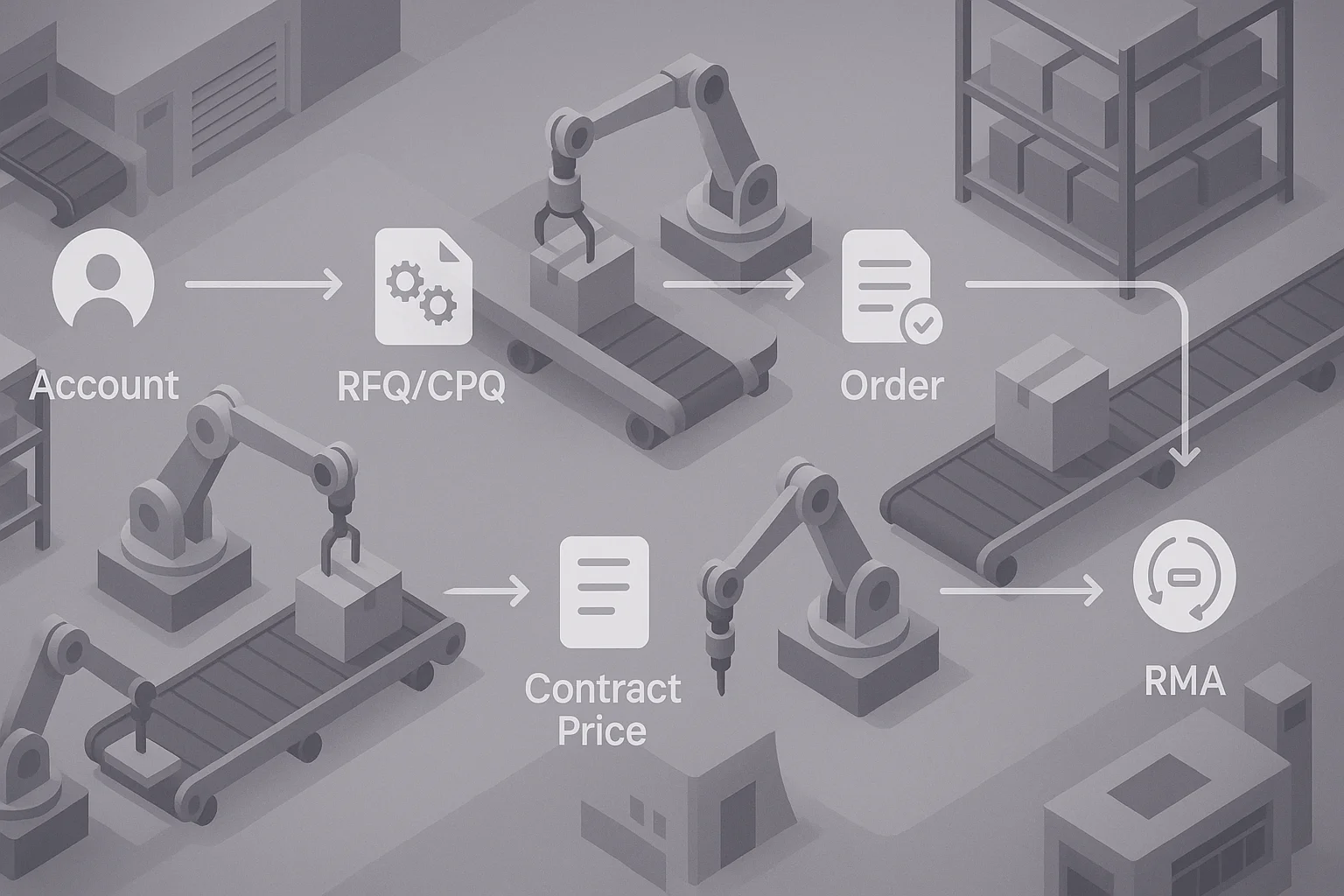Most manufacturers already know they need a dealer portal or B2B ecommerce site. That part is obvious.
What is not obvious is why things still feel messy even after you launch one. Prices do not match. Dealers complain about bad data. Sales reps bypass the portal. IT is buried in tickets. Leadership sees rising costs with unclear returns.
That is not a “platform problem.” That is a governance problem.
Understanding B2B Commerce Governance
B2B commerce governance is the way your company sets rules, ownership, and guardrails around your dealer portals, B2B storefronts, and digital sales stack so they stay aligned with how you actually sell and build product. It is not a new piece of software, a buzzword for “project management,” or a one-time transformation project. It is the operating model for your digital commerce ecosystem.
Governance answers the questions that keep your digital channels running smoothly. Who owns the dealer portal roadmap? Who decides pricing rules, programs, and exceptions? Which systems are the source of truth for pricing, inventory, and product data? How do changes get requested, approved, tested, and rolled out? What KPIs define success, and who is accountable when things break?
If no one can answer these questions clearly, you do not have governance. You have a website that is slowly drifting away from your real business.
Why Governance Matters for Manufacturers
Most manufacturers can get to “we have a portal” without much trouble. The problems show up later when sales wants special pricing logic for key dealers, marketing wants new content and promotions, operations wants stricter rules to stop bad orders, finance wants tighter control on discounting and tax logic, and IT is trying to keep everything glued together.
Without governance, every request becomes a one-off fight. The same dealer sees different prices depending on where they look. Product data and inventory live in multiple systems and rarely match. Orders arrive incomplete or wrong and operations eats the cost. Replatform projects drag on and still do not fix core issues. Everyone blames the portal, but the real problem is how decisions get made.
With B2B commerce governance, your digital channel stops being a random pile of features and turns into a controlled system of action that supports how you actually sell, quote, and build.
The Six Pillars of Effective B2B Commerce Governance
For a manufacturing company, effective governance usually covers six critical areas that work together to create a stable, scalable digital commerce operation.
1. Ownership and Decision Rights
The first rule of governance is simple: someone has to own it. That means clear answers to questions like who owns the dealer portal roadmap, who owns pricing rules and discount structures, who can approve custom deals and exceptions, and who signs off on changes before they go live.
Instead of “everyone has an opinion,” you define decision makers and simple escalation paths. Sales, IT, marketing, operations, and finance still collaborate, but it is clear who decides. This eliminates the endless circular discussions that paralyze progress and create frustration across teams.
2. Standards and Guardrails
Without standards, every urgent request becomes a one-off exception that slowly breaks the system. Governance sets the rules for how pricing, discounts, MAP, territories, and credit limits are handled across channels. It defines what a complete product record looks like, how SKUs are structured and categorized, and establishes rules for dealer eligibility, account hierarchy, and user roles.
These guardrails keep your portal from turning into a custom hack for every complaint, sales demand, or last-minute idea. They create consistency that dealers can trust and internal teams can rely on when making decisions.
3. Systems and Data Alignment
Governance defines where truth lives in your organization. The typical pattern has your ERP as the source of truth for inventory, pricing, tax, and credit. Your PIM holds the authoritative product data and attributes. Your CRM maintains the definitive records for accounts, contacts, and pipelines. The dealer portal reads from these sources instead of inventing its own.
Without this clarity, the portal quietly becomes a second ERP. It gets patched with its own “temporary” pricing rules and product data. After a few years, no one is sure which system to trust. Governance stops that from happening by establishing clear data flows and preventing the creation of shadow systems.
4. Change Management and Roadmap
B2B commerce is not static. New dealers, channels, programs, and regulations never stop coming. Governance gives you a structured way to collect requests from sales, dealers, and internal teams, score them based on impact on revenue, margin, and risk, build a roadmap that everyone can see, and release changes with a standard process so quoting, tax, and compliance do not break.
Instead of lurching from fire to fire, you have a clear pipeline of improvements and a known way to ship them safely. Teams understand when their requests will be addressed, and IT can plan capacity and testing appropriately.
5. KPIs and Reporting
If you are not measuring, you are guessing. Governance defines the KPIs that actually matter for B2B commerce, such as time from quote to order, dealer self-service rate, order accuracy and rework rate, fill rate and backorder rate, margin by channel and program, and system uptime and incident frequency.
These metrics turn your portal from “IT expense” into a measurable lever in your revenue and operations. They also prevent you from chasing features that look nice but do nothing for the business. When decisions are guided by data rather than opinions, progress becomes predictable and investments deliver returns.
6. Risk, Compliance, and Vendor Control
Manufacturers operate under real constraints including channel conflict and territory rules, MAP or MRP pricing policies, regulatory requirements and export controls, and industry-specific licensing requirements. B2B commerce governance makes sure these constraints are baked into the flows rather than bolted on afterward, that channel and compliance rules are enforced consistently rather than manually, and that vendors and integrators work inside your standards instead of locking you into their preferred tools and patterns.
You keep control of your stack, your data, and your rules, instead of letting your vendors define your business logic for you. This prevents the common trap where manufacturers find themselves unable to switch vendors or make changes without starting over from scratch.
The Warning Signs of Missing Governance
You can usually spot a lack of governance by recognizable symptoms. Dealers do not trust the portal and still email or call for quotes. Sales reps build their own spreadsheets, CPQ tools, or “shadow systems” to work around portal limitations. The portal shows stock that the warehouse does not actually have. Different teams copied product data into their own systems, and now nothing matches. Every change request feels like a mini transformation project. No one can clearly answer “Who owns this decision?”
In that environment, your B2B portal becomes a liability rather than an asset. Margins quietly erode through untracked discounting and exceptions. Operations absorbs the cost of fixing bad orders. IT is stuck in reactive mode instead of improving the stack. Leadership stops trusting the numbers that come out of the system.
The technology might be fine. The architecture might be fine. The missing piece is governance.
The Transformation That Governance Enables
With B2B commerce governance in place, the story changes completely. Dealers trust the portal because pricing, availability, and lead times are accurate. Sales, dealers, and inside teams work from the same rules. Product, pricing, and program changes flow through a simple, repeatable process. IT executes a clear roadmap tied to growth and profitability, not random tickets. Leadership gets regular reporting on adoption, accuracy, margin, and risk. Vendors work inside your standards instead of shaping your business to fit their platform.
The portal becomes a system of action where quotes move faster, orders are cleaner, dealer self-service goes up, manual work in the plant and front office goes down, and channel programs are enforced instead of negotiated one deal at a time.
Why Manufacturers Specifically Need This
If you sell directly to consumers only, your challenges are simpler. If you sell through dealers, distributors, and reps, your world is different. You deal with territories and channel conflict, contract pricing and partner programs, complex BOMs with long lead times and configuration rules, compliance and regulatory constraints, and legacy systems that are deeply tied to how you schedule, build, and ship.
In that environment, just “launching a portal” is not enough. You need a way to keep that portal aligned with reality as your business keeps changing. That is exactly what B2B commerce governance does. It keeps your digital channel from drifting into a tangle of one-off fixes that no one owns and turns it into a durable asset that protects your margins, strengthens dealer relationships, reduces friction in quoting and ordering, and gives leadership clear visibility into what is working and what is not.
Final Thought
B2B commerce governance is not exciting on the surface. There are no flashy dashboards or hype terms attached to it. But if you look at manufacturers who actually get their digital channels under control, you will find the same pattern every time: clear ownership, simple decision rules, standardized data, a real roadmap, hard KPIs, and tight control over risk and vendors.
That is governance. If your portal feels chaotic today, technology might not be your first problem. Fix the governance and the rest of the stack becomes a lot easier to improve.
At Metrotechs.io, we help manufacturers build and maintain the governance frameworks that turn B2B commerce from a source of friction into a competitive advantage. Contact us to learn how we can help you establish the ownership, standards, and systems alignment that make digital commerce work for your business.






